| Pages:
1
2 |
Lion850
National Hazard
   
Posts: 514
Registered: 7-10-2019
Location: Australia
Member Is Offline
Mood: Great
|
|
Hi Bezaleel thanks for linking to the thread, interesting stuff. So far I was trying to get coloured metal cyanurate salts while not including alkali
metals (or chlorine). But these reactions takes days! Yes the nickel salt in solution goes from grey at room temp to blue-green near boiling and then
back to grey again upon cooling. Seems this reverse only happens in water. Not when dry, but more investigation is needed.
I hope to start with iron in the next day or so.
|
|
|
Lion850
National Hazard
   
Posts: 514
Registered: 7-10-2019
Location: Australia
Member Is Offline
Mood: Great
|
|
Failures:
Chromium: I tried a few different things over many days. Chrome powder was stirred with cyanuric acid solution in different rations, each attempt for
some 3 days hot. In each case I got a light brown solution after only a few hours and a gram or so of brown ppt (mixed with unreacted cyanuric acid
and unreacted metal powder). Looks like something wants to start but then does not progress.
I tried mixing solutions of sodium cyanurate with chromium iii nitrate solution in different ratios with hours of stirring hot; I did get some 4 gram
of a pale green powder (which readily dissolves in HCl giving a beautiful deep green solution); a very poor yield and again apparently remaining
sodium cyanurate as ppt as well as nitrate in solution so it seems an equilibrium is reached and the reaction does not proceed.
Iron: I tried to react freshly prepared iron hydroxide with cyanuric acid; what resulted after days of stirring basically was the same dark brown mess
as the original iron hydroxide. But something did happen, because a soluble salt formed that resulted in a light brown filtrate when I did the final
filtering (when I first made the iron hydroxide the filtrate was clear).
Still a few more things to try....
|
|
|
Lion850
National Hazard
   
Posts: 514
Registered: 7-10-2019
Location: Australia
Member Is Offline
Mood: Great
|
|
I did a few crude small scale double displacement reactions to see whether anything warranted further investigations. 10gram of sodium cyanurate (most
likely the monosubstituted salt NaH2C3N3O3.xH2O) was dissolved in 150ml boiling water; this was kept at boiling to keep the salt dissolved. 15ml of
this clear solution was then mixed with the below to see what happens:
Copper sulfate: 1.9g was dissolved in 10g water and the blue solution mixed with the sodium cyanurate. This was a control as the expected reaction was
known. And as expected the solution turned purple slowly, and when stirring was stopped a purple ppt settled.
Basic cerium sulphate: 1g was dissolved in 15ml water and the the yellow solution mixed with the sodium cyanurate. Not much happened, if anything the
solution became more clear. No sign of any ppt.
Erbium acetate: 1.5g was dissolved in 10g water, giving a pink solution. When this was mixed with the sodium cyanurate the color became slightly more
purple but there was no ppt.
Iron sulfate monohydrate: 2g was dissolved in 12g water. When this cloudy solution was mixed with the sodium cyanurate, the color changed to olive
green and a pale olive green ppt settled. Where some of the ppt splashed up on the side of the beaker it turned brown. I suspect an iron ii cyanurate
formed which was easily changed to iron iii by the exposure to air? This is to be investigated further.
Lead nitrate: 2g was dissolved in 10g water and the clear solution mixed with the sodium cyanurate. The solution immediately went milky white and a
white ppt settled.
Nickel nitrate: 1,5g was dissolved in 12g water and the deep green solution mixed with sodium cyanaurate. The solution immediately went lime green and
a very pale green ppt settled. The be investigated further,
Tin ii chloride: 1.6g was stirred in 15g water, and the near clear solution mixed with sodium cyanurate. The solution became cloudy and a white ppt
formed.
Titanium iii chloride: 1.5g was dissolved in 12g water giving a purple solution. As this was poured into the hot sodium cyanurate solution it first
went black (or very dark) and then grey and eventually pale flesh colored. And each time some was poured in gas seemed to be evolved. The solution was
filtered. The filtrate was clear. A bit of the wet pale flesh colored remainder was heated in a small crucible to around 200 C, it dried out but kept
the same color. Once cooled, concentrated HCl was added. The salt readily dissolved in the hydrochloric acid, giving a clear solution. This surprised
me, I was expecting to see the purple color of titanium iii again. A few drops of 35% hydrogen peroxide was added, and it turned blood red which I
think support the presence of titanium in solution.
Did the titanium change oxidation state, and is this linked to the gas that seemed to be given off (no smell)?
To be investigated further.
I will appreciate any advice as to how the observations with the titanium may be explained.
|
|
|
sciece nerd
Harmless

Posts: 25
Registered: 27-8-2019
Member Is Offline
|
|
A clear solution which turns red when adding hydrogen peroxide indicates the presence of Ti (IV), as the peroxo complex of that is deep red.
I think the basic nature of monosodium cyanurate turned Titanium (III) chloride into strongly reducing Titanium (III) hydroxide (deep blue, almost
black) and itself turning into cyanuric acid precipitate, the Ti (III) hydroxide quickly reduces water producing hydrogen (the gas) and is oxidized to
white hydrous TiO2. (Hydrogen is immediately produced but it takes quite long for all the Ti(OH)3 to turn white)
The flesh color may be caused by impurities or another unknown compound.
[Edited on 25-7-2020 by sciece nerd]
[Edited on 25-7-2020 by sciece nerd]
|
|
|
Lion850
National Hazard
   
Posts: 514
Registered: 7-10-2019
Location: Australia
Member Is Offline
Mood: Great
|
|
@sciece nerd Thanks for the explanation. So part of the remainder on the filter paper was fresh TiO2 which then dissolved in the concentrated HCl?
This is interesting because my experience with purchased TiO2 is that it does not dissolve in HCl. Being freshly made and dried at lowish temp may be
why it dissolved?
When I next get time in the shed I’ll see what happens if a TiCl3 solution is added to a cyanuric acid solution (not the sodium cyanurate salt) thus
in a slightly acidic medium.
|
|
|
sciece nerd
Harmless

Posts: 25
Registered: 27-8-2019
Member Is Offline
|
|
I think yes.
|
|
|
Lion850
National Hazard
   
Posts: 514
Registered: 7-10-2019
Location: Australia
Member Is Offline
Mood: Great
|
|
Sciece Nerd for your interest this morning I added some H2O2 drops to the filtrate from yesterday - and there was no color change. So only the
remainder gave the red color change (after dissolving it in HCl).
|
|
|
Bezaleel
Hazard to Others
  
Posts: 444
Registered: 28-2-2009
Member Is Offline
Mood: transitional
|
|
I can confirm that only freshly precipitated TiO2 will dissolve in HCl solution. Both anatase and rutile in particular will not dissolve in HCl,
neither after long reflux.
Ti(IV) is colourless in HCl solution, but there also exists a strongly coloured brown mixed III-IV oxide, which forms from Ti(III) solutions on
exposure to air. The very intense brown colour arises from a change transfer process (and quickly spoils the beauty of the violet from Ti(III)).
I have seen reduction back to Ti(III) in HCl solution by adding a piece of zinc.
|
|
|
Lion850
National Hazard
   
Posts: 514
Registered: 7-10-2019
Location: Australia
Member Is Offline
Mood: Great
|
|
Nickel cyanurate
According to "Cyanuric Acid and Cyanurates by GB Seifer" nickel can form either a monosubstituted salt NiH2C3N3O3.xH2O or a disubstituted salt
NiHC3N3O3.xH2O. I considered the following equation for the stoichiometry:
2NiCO3 + 2H3C3N3O3.2H2O + 4H2O = 2NiH2C3N3O3 + 2CO2 + H2O2
- 5g cyanuric acid (probably the dihydrate) was added to a beaker with 100ml water and heated to boiling to dissolve with continuous stirring. The
water was increased in stages until around 170ml gave a clear solution.
- 3g nickel carbonate was added to the hot solution. Tiny bubbles were observed and the solution was left to stir overnight.
- The next morning there was still some of the larger bits of the carbonate seen swirling around. Another 2 gram of carbonate was added bringing the
total to 5g and another 3g of cyanuric acid was added bringing the total to 8g. See photo of carbonate pieces swirling around.
** 8h cyanuric acid dihydate reacting with 5g nickel carbonate and expecting the monosubstituted salt should put the cyanuric acid in excess (and even
more in excess if only the disubstituted salt formed). I wanted the cyanuric acid in excess, and not the carbonate, to get all the carbonate to react
as I knew excess cyanuric acid could be washed out later with boiling water.
- The solution was left to stir hot for a total of around 50 hours. The level of the beaker was topped up to around the 150ml mark every morning and
evening to make up for losses.
- After some 38hrs there was a thick lime green suspension with no more carbonate solid, but stirring was continued for another 12 hours (total around
50). See photo of the final solution.
- The solution was vacuum filtered, and the lime green remainder washed twice with excess boiling water in the filter. See photo.
- The filtrate was very pale green, so the final product is very slightly soluble in water. Once the filtrate cooled to room temperature the solution
remained green, but some white ppt was seen, most likely the excess cyanuric acid.
- The lime green remainder was dried on a steam bath until the weight remained stable. Total drying time was around 5 hours.
The theoretical yield was around 8g, if the product was the anhydrous monosubstituted salt. The total recovery was 9.6g, probably due to it being a
hydrate.
The only test I did on the product was to add some to concentrated hydrochloric acid. There was no immediate reaction. See photo of final product in
bottle.
Neodymium carbonate and cyanuric acid is currrently stirring in the shed. Report to follow once completed.
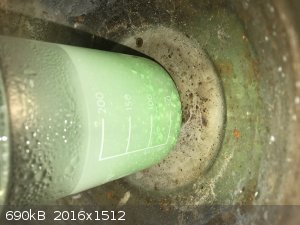 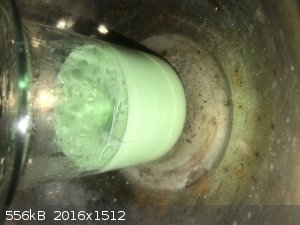 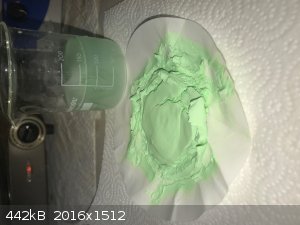 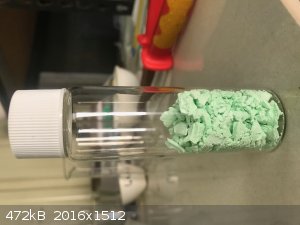
|
|
|
woelen
Super Administrator
        
Posts: 7976
Registered: 20-8-2005
Location: Netherlands
Member Is Offline
Mood: interested
|
|
This looks very much like the carbonate. How can you be sure that the carbonate is fully converted? I can imagine that there is carbonate, covered
with a layer of cyanurate.
Another interesting experiment would be the following:
- Add nickel carbonate to some dilute HNO3. Use excess nickel carbonate. Heat this mix and stir for a while in order to be sure that all nitric acid
is used up and you have a solution of nickel nitrate. Filter the solution, so that you have a clear solution of nickel nitrate.
- Dissolve NaOH in water and dissolve as much as possible of cyanuric acid in that. The solution should have a pH not above 11. That would be a good
indication that there hardly is any free hydroxide left.
- Mix the solutions of nickel nitrate and sodium cyanurate and see what kind of precipitate is formed.
With this experiment you start with all ions in solution and there is no risk of having solid matter, unreacted, which is covered by a thin layer of
product.
|
|
|
Lion850
National Hazard
   
Posts: 514
Registered: 7-10-2019
Location: Australia
Member Is Offline
Mood: Great
|
|
Woelen - I was indeed weary of some carbonate being left over. That's why the cyanuric acid is in excess and the mixture was stirred near boiling
another 12 hours after is seemed there was no more change slowly taking place.
The product certainly does not immediately react with HCl as does the raw nickel carbonate. But some carbonate remaining somewhere is for sure a
possibility. What I can add to the above report is that product eventually dissolve in the concentrated HCl giving a slightly green solution, no
visible sign of CO2 at any point.
If you look at the 3rd post on this page you will see that I previously did a series of crude tests reacting various metal salts with a solution of
sodium cyanurate to see what warrants further experimenting, and I wrote for Nickel:
"Nickel nitrate: 1,5g was dissolved in 12g water and the deep green solution mixed with sodium cyanaurate. The solution immediately went lime green
and a very pale green ppt settled. The be investigated further"
What I can try is to react a clear solution of cyanuric acid with a solution of nickel nitrate assuming the monosubstituted salt will form and then a
10% or so excess of cyanuric acid. This avoids having sodium in the reaction and thus avoid the possibility of a sodium-nickel-cyanurate complex.
I now also have nickel metal powder. I can stir nickel powder with hot cyanuric acid solution as I did with copper powder. The copper powder
eventually gave a beautiful deep purple compound, but after nearly 100 hours!
|
|
|
woelen
Super Administrator
        
Posts: 7976
Registered: 20-8-2005
Location: Netherlands
Member Is Offline
Mood: interested
|
|
I missed the remark about the nickel nitrate in your 3rd post. Given your description of the precipitate, I am more convinced that your pale green
precipitate you have not indeed is nickel cyanurate. What remains though is the possibility of still having carbonate in it.
Using NaOH as I suggest in my previous post introduces the risk of coprecipitation of sodium ions. I do not expect any serious complex formation with
Na, nor any double salt formation. Such things are very rare with sodium ions. What I usually do with that kind of things is letting the precipitate
settle (takes one day), then decanting all clear solution above it, and then adding a lot of water again and stirring for a while and letting it
settle again. Especially if the precipitate is somewhat slimy and no real crystals can be seen, the contact with the liquid is very good and the
sodium can go freely in the water. Each rinse then dilutes the sodium contents with a factor of 10 or 20 and usually with two rinses only a few tenths
of percents of the sodium is left. With this, of course, I assume that no complex or double salt is formed.
|
|
|
Lion850
National Hazard
   
Posts: 514
Registered: 7-10-2019
Location: Australia
Member Is Offline
Mood: Great
|
|
Woelen - an update on nickel:
I dissolved 10g cyanuric acid in 300ml boiling water (all dissolved to clear solution) and then added 2.8g NaOH (forgot to take the pH). To this hot
solution I then added a solution of 18g nickel nitrate hexahydrate. A lime green suspension formed. The solution was vacuum filtered, and the lime
green remainder dried on a steam bath. The filtrate was still surprisingly green, although not as deep green as the original nickel nitrate solution.
The dry product looks exactly like the lime green powder I got before. See photo showing both. I did some tests on both the products:
When heated to 200+ degrees (in a small crucible with a lid on directly on my hotplate) the color turns from lime green to tan after some 10 minutes.
See photo. What the crucible lid is removed (when still hot) there is no smell but only white fumes which looks like steam. The tan color remains the
same when it is cooled to room temp, but when the tan powder is wetted with water it returns to lime-like color. See photo. So this change looks
purely like a change in hydration.
I added small bits to each of sulphuric acid (>95%), nitric acid (70%), and hydrochloric acid (35%) and stirred with a stainless spatula for a few
minutes (at room temp). There seems to be little if any reaction with the sulphuric or nitric acid, but with the hydrochloric acid it slowly forms a
pale green solution which has a hint of blue if more water is added.
What surprised me is that the recovery of the lime green remainder once dried was only 6g. I expected more. I'm not sure if some disubstituted salt
also formed and stayed in solution; which may also explain why the filtrate was still quite green.
I also wondered whether the nickel nitrate reacted with the NaOH and formed nickel hydroxide; but I would have expected the hydroxide to be easily
soluble in all 3 the acids. And photos online shows nickel hydroxide to be more green; not lime green.
What I will try next is to stir nickel powder with hot cyanuric acid (for days) and see if I get something.
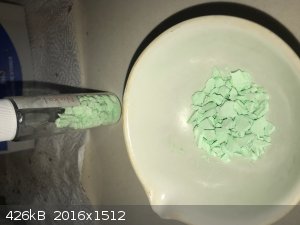 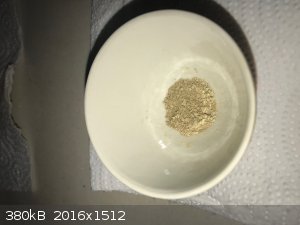 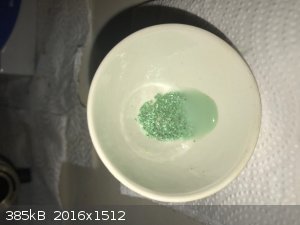
|
|
|
watercoach
Harmless

Posts: 2
Registered: 11-12-2017
Member Is Offline
Mood: No Mood
|
|
Hello. I am new here but found your discussion while searching on Google about cyanuric acid removal. I am a chemist in the swimming pool industry and
identified copper cyanurate purple crystals around 1982. No one had every heard of this compound but many pool service techs had seen it but had no
idea what it was. I was asked about it and with the help of XRF at Monsanto Company, we identified the compound as copper cyanurate possibly with
ammonia. . Copper cyanurate and ammonia complexes are present in swimming pool water. I was the first one to determine that the purple crystals on
metal components, plastic and plaster in some pools were copper cyanurate in 1982 with the help of an XRF (x-ray diffraction which was pretty new) and
Monsanto Company helping to identify it from the powder print. I wrote about these purple crystals in a training manual I wrote called "IPSSA
Intermediate Training Manual" in 2008 but had been telling people about it in seminars since 1983.
And now they discovered that the copper cyanurate is a gem found in small cracks in the rock covered in bat shit in the mountains of Northern Chile,
near the border with Perú. You could have a potential income stream from harvesting purple crystals from your poorly cared for pool.
Joanneumite, Cu(C3N3O3H2)2(NH3)2, a new mineral from Pabellón de Pica, Chile and the crystal structure of its synthetic analogue
Abstract
The new mineral joanneumite was found at Pabellón de Pica Mountain, Iquique Province, Tarapacá Region, Chile, where it occurs as violet
microcrystalline aggregates up to 2 mm in size in small cracks in a gabbroic rock, which is covered by a guano deposit. Associated minerals are
salammoniac, dittmarite, möhnite and gypsum. Joanneumite is non-fluorescent and the Mohs hardness is 1. The calculated density is 2.020 g cm–3. The
infrared spectrum of joanneumite shows the frequencies of NH3 and isocyanurate groups and the absence of absorptions of H2O molecules and OH– ions.
The chemical composition (electron microprobe data, the hydrogen was calculated from the structural formula, wt.%) is C 20.33, N 31.11, O 28.34, Cu
17.27, Zn 0.24, H 2.82, total 100.11. The empirical formula is Cu0.96Zn0.01N7.84C5.98O6.25H9.96 and the idealized formula is CuN8C6O6H10 with the
structural formula Cu(C3N3O3H2)2(NH3)2. Due to the lack of suitable single crystals the synthetic analogue of joanneumite was prepared for the
single-crystal structure refinement. The crystal structure was solved and refined to R = 0.025 based upon 1166 unique reflections with I > 2σ (I).
Joanneumite is triclinic, space group P1̄, a = 4.982(1), b = 6.896(1), c = 9.115(2) Å, α = 90.53(3), β = 97.85(3), γ = 110.08(3)°, V = 290.8(1)
Å3, Z = 1 obtained from single-crystal data at 100 K, which are in good agreement with cell parameters from powder diffraction data of joanneumite at
293 K: a = 5.042(1), b = 6.997(1), c = 9.099(2) Å, α = 90.05(3), β = 98.11(2), γ = 110.95(3)° and V = 296.3(1) Å3. The eight strongest lines of
the powder X-ray diffraction pattern are [d, Å (I,%) (hkl)] 6.52 (68) (010), 5.15 (47) (011), 4.66 (21) (100, 110), 4.35 (9) (1̄11), 3.29 (6)
(1̄20), 3.22 (7) (1̄1̄1), 3.140 (100) (1̄21), 2.074 (7) (1̄32). The crystal structure of joanneumite is identical with the structure of synthetic
bis(isocyanurato) diamminecopper(II).
Just adding to your discussion.
|
|
|
Lion850
National Hazard
   
Posts: 514
Registered: 7-10-2019
Location: Australia
Member Is Offline
Mood: Great
|
|
Hi Watercoach thanks for the info about Joanneumite. Do you perhaps have a procedure for the lab synthesis of this compound?
|
|
|
watercoach
Harmless

Posts: 2
Registered: 11-12-2017
Member Is Offline
Mood: No Mood
|
|
I am sorry. I do not. It is not understood how the copper cyanurate forms in swimming pools. We have plenty of CYA (50 to 200 mg/l) from using
trichloroisocyanurate (chlorine tabs) as the chlorine source and there is some amount of copper in the water due to incoming replacement water,
erosion, corrosion, copper-based algaecides, and Cu-Ag ionizers. But there must be some other condition that initiates the precipitation of copper
cyanurate or else all pools would have the purple crystals. I suspect that the pH in the water gets low (<7.2), copper (>0.5 mg/l) and cyanurate
(>200 mg/l) with some amount of chloramine or ammonia present, and then the pH is abruptly raised to ~7.5. UV from sunlight may also play a role. I
have seen purple crystals covering metal light rings, ladders and escutcheons. In some cases it covers plastic skimmers and return water fittings.
|
|
|
| Pages:
1
2 |